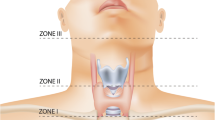Abstract
Based on only one objective and several subjective signs, the forensic classification of strangulation incidents concerning their life-threatening quality can be problematic. Reflecting that it is almost impossible to detect internal injuries of the neck with the standard forensic external examination, we examined 14 persons who have survived manual and ligature strangulation or forearm choke holds using MRI technique (1.5-T scanner). Two clinical radiologists evaluated the neck findings independently. The danger to life was evaluated based on the “classical” external findings alone and in addition to the radiological data. We observed hemorrhaging in the subcutaneous fatty tissue of the neck in ten cases. Other frequent findings were hemorrhages of the neck and larynx muscles, the lymph nodes, the pharynx, and larynx soft tissues. Based on the classical forensic strangulation findings with MRI, eight of the cases were declared as life-endangering incidents, four of them without the presence of petechial hemorrhage but with further signs of impaired brain function due to hypoxia. The accuracy of future forensic classification of the danger to life will probably be increased when it is based not only on one objective and several subjective signs but also on the evidence of inner neck injuries. However, further prospective studies including larger cohorts are necessary to clarify the value of the inner neck injuries in the forensic classification of surviving strangulation victims.




Similar content being viewed by others
References
Brinkmann B, Püschel K (eds) (1990) Ersticken-Fortschritte in der Beweisführung. Springer, Berlin Heidelberg New York
Härm T, Rajs J (1981) Types of injuries and interrelated conditions of victims and assailants in attempted and homicidal strangulation. Forensic Sci Int 18(2):101–123
Brinkmann B (2004) Ersticken. In: Brinkmann B, Madea B (eds) Handbuch Gerichtliche Medizin. Springer, Berlin Heidelberg New York, pp 761–794
Mueller B (1975) Erstickung. In: Mueller B (ed) Gerichtliche Medizin. Springer, Berlin Heidelberg New York, pp 439–464
Di Maio DJ, Di Maio VJM (1989) Strangulation. In: Di Maio DJ, Di Maio VJM (eds) Forensic pathology, 1st edn. CRC Press, New York, pp 222–244
Meier C (2005) Die Lebensgefährdung. Ph.D. Thesis, University of Freiburg, Switzerland
Jackowski C, Thali M, Aghayev E, Yen K, Sonnenschein M, Zwygart K, Dirnhofer R, Vock P (2005) Postmortem imaging of blood and its characteristics using MSCT and MRI. Int J Legal Med 19:1–8
Jackowski C, Aghayev E, Sonnenschein M, Dirnhofer R, Thali MJ (2006) Maximum intensity projection of cranial computed tomography data for dental identification. Int J Legal Med 120(3):165–167
Yen K, Sonnenschein M, Thali MJ, Ozdoba C, Weis J, Zwygart K, Aghayev E, Jackowski C, Dirnhofer R (2005) Postmortem multislice computed tomography and magnetic resonance imaging of odontoid fractures, atlantoaxial distractions and ascending medullary edema. Int J Legal Med 119(3):129–136
Hayakawa M, Yamamoto S, Motani H, Yajima D, Sato Y, Iwase H (2006) Does imaging technology overcome problems of conventional postmortem examination? A trial of computed tomography imaging for postmortem examination. Int J Legal Med 120(1):24–26
Schulz R, Muhler M, Mutze S, Schmidt S, Reisinger W, Schmeling A (2005) Studies on the time frame for ossification of the medial epiphysis of the clavicle as revealed by CT scans. Int J Legal Med 119(3):142–145
Yen K, Thali MJ, Aghayev E, Jackowski C, Schweitzer W, Boesch C, Vock P, Dirnhofer R, Sonnenschein M (2005) Strangulation signs: initial correlation of MRI, MSCT, and forensic neck findings. J Magn Reson Imaging 22(4):501–510
Bradley WG (1999) Hemorrhage. In: Stark DD, Bradley WG (eds) Magnetic resonance imaging. Mosby, St. Louis, pp 1329–1359
Castelijns JA, van den Brekel MW, Niekoop VA, Snow GB (1996) Imaging of the larynx. Neuroimaging Clin N Am 6(2):401–415
Lupetin AR, Hollander M, Rao VM (1998) CT evaluation of laryngotracheal trauma. Semin Musculoskelet Radiol 2(1):105–116
Borowski DW, Mehrotra P, Tennant D, El Badawey MR, Cameron DS (2004) Unusual presentation of blunt laryngeal injury with cricotracheal disruption by attempted hanging: a case report. Am J Otolaryngol 25(3):195–198
Stanley RB Jr, Hanson DG (1983) Manual strangulation injuries of the larynx. Arch Otolaryngol 109(5):344–347
Plattner T, Bolliger S, Zollinger U (2005) Forensic assessment of survived strangulation. Forensic Sci Int 153(2–3):202–207
Author information
Authors and Affiliations
Corresponding author
Rights and permissions
About this article
Cite this article
Yen, K., Vock, P., Christe, A. et al. Clinical forensic radiology in strangulation victims: forensic expertise based on magnetic resonance imaging (MRI) findings. Int J Legal Med 121, 115–123 (2007). https://doi.org/10.1007/s00414-006-0121-y
Received:
Accepted:
Published:
Issue Date:
DOI: https://doi.org/10.1007/s00414-006-0121-y




